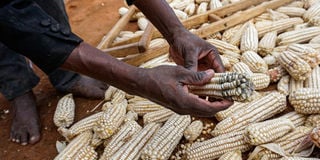Prime
Maize is most cultivated crop in Uganda - Ubos

Maize is more cultivated than any other crop in Uganda, according to Ubos. PHOTO/FILE
What you need to know:
- Maize, which is largely grown in Buganda north, Bunyoro and Buganda south is the most cultivated temporary crop grown by agricultural households in Uganda.
Maize is the most cultivated crop in Uganda, according to Uganda Bureau of Statistics (Ubos).
According to a survey released Monday, Ubos indicated that 69 percent of agriculture households during the 2019 planting season, cultivated maize as a temporary crop, producing 2.8 million metric tonnes.
Speaking during release of findings of the 2019 Agricultural Survey in Kampala, Ms Flavia Oumo, the Ubos senior statistician department of production and environment, said Buganda north, which, during the period produced 710,000 metric tonnes, leads in maize cultivation, followed by Bunyoro at 561,000 metric tonnes and Buganda south at 266,000 metric tonnes.
At least 63.4 percent of the produced maize, the findings indicate, is sold in unprocessed form while 27.4 percent used for own consumption.
Beans, which are mostly produced in Bunyoro (77,400 metric tonnes), Ankole (72,600 metric tonnes) and North Buganda (72,300 metric tonnes) follow maize at 54 percent followed by beans, whose cultivation stands 54 percent of agricultural household.
Beans are mainly cultivated in Bunyoro (77,400 metroc tonnes), Ankole (72,600 metroc tonnes) and North Buganda (72,300 metroc tonnes).
The three, the survey indicates, are followed by banana cultivation, which during the period increased to 47 percent from 40 percent in 2018.
Ankole, which produces 3.5 million metric tonnes, cultivates more bananas than any other region. It is followed by Tooro and Buganda South, which each produce 1.7 million metric tonnes.
At least, according to Ms Oumo, 62 percent of produced bananas are used for own consumption. Sweet potatoes come in at fifth with a cultivation coverage of 32 per cent, which produces 21.1 metric tonnes.
North Buganda, which produced 253,000 metric tonnes, contributes the largest portion, followed by Busoga (174,000 metric tonnes) and Lango (139,000 metric tonnes).
Coffee, one of Uganda’s largest foreign exchange earners, is largely less cultivated.
Only 7 percent out of the agriculture households cultivate Arabica coffee while 21 percent grow Robusta, largely produced in the Elgon subregion and Tooro.
However, according to Ms Oumo, coffee cultivation decreased by 16 percent .
At least 11 percent of agricultural household cultivate millet, producing 73,000 metric tonnes annually.
The largest chunk of millet cultivators live in Ankole with an annual production of 14,000 metric tonnes followed by Acholi (13,000 metric tonnes) and Lango (11,000 metric tonnes).
Much of the millet, the survey notes, is used for own consumption.
Rice cultivation stands at 4 percent or 167,000 metric tonnes with the largest production coming from Busoga (50,000 metric tonnes), followed by Acholi (19,000 metric tonnes and Buganda north (18,000 metric tonnes.
However, Ms Oumo said, production of rice had decreased by 16 percent. Much of the rice, she noted, is sold in unprocessed form (59.5 percent).
Other crops
At least 29 percent of agriculture household cultivate groundnuts, which has an annual production of 133,000 metric toones. Groundnuts, the survey shows, are mostly cultivated in Teso (20,000 metric tonnes), Acholi (15,000 metric tonnes) and West Nile (13,000 metric tonnes).
Soya beans is among the least cultivated crop. Only 8 percent of households cultivate it while only 5 percent cultivate sim sim in the areas of Acholi (16,000 metric tonnes), Lango (15,000 metric tonnes) and West Nile (94,000 metric tonnes)
Irish potatoes are cultivated by only 7 percent of agricultural households with the biggest cultivators living in the Kigezi sub region (61,000 metric tonnes) and Tooro (94,000 metric tonnes).
Offering alternative
Zambia blocked Kenyan milk from accessing its market about 13 years ago over standard issues.
Kenya has since, through its High Commission office in Lusaka, attempted to has reverse the impasse in vain.
Zambia offers hope to Uganda for an alternative.




